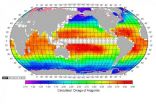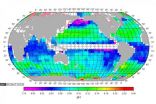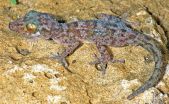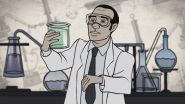(Press-News.org) A team of scientists has published the most comprehensive picture yet of how acidity levels vary across the world's oceans, providing a benchmark for years to come as enormous amounts of human-caused carbon emissions continue to wind up at sea.
"We have established a global standard for future changes to be measured," said Taro Takahashi, a geochemist at Columbia's Lamont-Doherty Earth Observatory who published the maps with his colleagues in the August issue of the journal Marine Chemistry. The maps provide a monthly look at how ocean acidity rises and falls by season and geographic location, along with saturation levels of calcium carbonate minerals used by shell-building organisms. The maps use 2005 as a reference year and draw on four decades of measurements by Lamont-Doherty scientists and others.
The oceans have taken up a quarter of the carbon dioxide humans have put in the atmosphere over the last two hundred years. But their help in offsetting global warming has come at a price: the oceans are growing more acidic as they absorb our excess CO2. To what extent ocean acidification may harm marine life and ecosystems is still unclear, but already signs of stress have appeared in corals, mollusks and other shell-builders living in regions with naturally more acidic water. Since the industrial era began, average surface seawater pH in temperate oceans has fallen from 8.2 to 8.1 by 0.1 pH unit, equal to a 30 percent increase in acid concentration. (A lower pH indicates more acidic conditions.)
The vast tropical and temperate oceans, where most coral reefs grow, see the least variation, with pH hovering between 8.05 and 8.15 as temperatures fluctuate in winter and summer. Here, the waters are oversaturated with respect to the mineral aragonite--a substance that shell-building organisms need to thrive.
Ocean pH fluctuates most in the colder waters off Siberia and Alaska, the Pacific Northwest and Antarctica. In spring and summer, massive plankton blooms absorb carbon dioxide in the water, raising pH and causing seawater acidity to fall. In winter, the upwelling of CO2-rich water from the deep ocean causes surface waters to become more acidic. Acidification of the Arctic Ocean in winter causes aragonite levels to fall, slowing the growth of pteropods, planktic snails that feed many predator fish.
The maps reveal that the northern Indian Ocean is at least 10 percent more acidic than the Atlantic and Pacific oceans, which could be due to its unique geography. Cut off from the Arctic Ocean, the chemistry of the northern Indian Ocean is influenced by rivers draining the massive Eurasian continent as well as seasonal monsoon rains.
By analyzing long-term data collected off Iceland, Bermuda, the Canary Islands, Hawaii and the Drake Passage, off the southern tip of South America, Takahashi finds that waters as far north as Iceland and as far south as Antarctica are acidifying at the rate of 5 percent per decade. His estimate corresponds to the amount of CO2 humans are adding to the atmosphere, and is consistent with several recent estimates, including a 2014 study in the journal Oceanography led by Nicholas Bates, research director at the Bermuda Institute of Ocean Sciences.
"This is exactly what we'd expect based on how much CO2 we've been putting in the air," said Rik Wanninkhof, a Miami-based oceanographer with the National Oceanic and Atmospheric Administration (NOAA) who was not involved in the study. "This is an important point for scientists to underscore--these calculations are not magic."
If the current pace of ocean acidification continues, warm-water corals by 2050 could be living in waters 25 percent more acidic than they are today, said Takahashi. While corals can currently tolerate shifts that big, marine biologists wonder if they can sustain growth at lower pH levels year-round. "In the long run it is the average pH that corals see that matters to their ability to grow and build a coral reef," said Chris Langdon, a marine biologist at the University of Miami, who was not involved in the study.
Ocean acidification is already having an impact, especially in places where the seasonal upwelling of deep water has made seawater naturally more acidic. In a recent study by researchers at NOAA, more than half of the pteropods sampled off the coast of Washington, Oregon and California showed badly dissolved shells. Ocean acidification has been linked to fish losing their ability to sniff out predators, and the die-off of baby oysters in hatcheries off Washington and Oregon, where more acidic deep water comes to the surface each spring and summer.
By 2100, ocean acidification could cost the global economy $3 trillion a year in lost revenue from fishing, tourism and intangible ecosystem services, according to a recent United Nations report. The U.S. Government Accountability Office, the watchdog arm of Congress, has reached similar findings and recommended that President Obama create a research and monitoring program dedicated to ocean acidification.
INFORMATION:
Other authors of the study: Stuart Sutherland, David Chipman (now retired), John Goddard and Cheng Ho, all of Lamont-Doherty; and Timothy Newberger, Colm Sweeney and David Munro, all of University of Colorado, Boulder.
Research scientists at VTT Technical Research Centre of Finland have demonstrated a new technique for generating electrical energy. The new method can be used in harvesting energy from mechanical vibrations of the environment and converting it into electricity. Energy harvesters are needed, for example, in wireless self-powered sensors and medical implants, where they could ultimately replace batteries. In the future, energy harvesters can open up new opportunities in many application areas such as wearable electronics.
Research scientists at VTT have successfully generated ...
New Rochelle, NY, November 10, 2014--To understand their risk for hereditary forms of cancer, such as breast and colon cancer, women need to know their family history. The design and effectiveness of a 20-minute skills-based intervention that can help women better communicate with relatives and gather and share information about cancer family history is described in a study in Journal of Women's Health, a peer-reviewed publication from Mary Ann Liebert, Inc., publishers. The article is available free on the Journal of Women's Health website at http://online.liebertpub.com/doi/full/10.1089/jwh.2014.4754 ...
A new drug combination for rheumatoid arthritis treats the disease just as well as other intensive treatment strategies but with less medication and fewer side effects at a significantly lower cost. Doctoral researcher Diederik De Cock (KU Leuven) describes the strategy in a new study published in Annals of Rheumatic Diseases.
Rheumatoid arthritis (RA) is a chronic auto-immune disease that causes pain and stiffness in the joints, fatigue, bone damage and, eventually, loss of mobility. RA afflicts around 1% of people in the western world; in Belgium, 80,000 to 100,000 ...
Hidden away in the tropical darkness of nocturnal Madagascar, scientists have discovered a new species of gecko which has been described in the open access journal Zoosystematics and Evolution.
A master of disguise, the new species Paroedura hordiesi has camouflage pattern to blend with its natural habitat, while climbing on rocks and the ruins of an old fort, where it was spotted by scientists.
Home of the new gecko, the karstic limestone massifs in the region of northern Madagascar are believed to still harbour further undescribed reptile species, some of which might ...
BOSTON - The innate immune system serves as the body's specialized armed forces division, comprised of a host of defense mechanisms used to battle bacterial infections. Among the system's warriors are white blood cells including the specialized macrophages, which maintain constant surveillance for foreign intruders or pathogens, functioning as the body's first line of defense, poised to attack at barrier sites including the skin, lungs and intestines.
Now, a research team led by investigators at Beth Israel Deaconess Medical Center (BIDMC) finds that naturally occurring ...
Recognizing the emotions other people feel is crucial for establishing proper interpersonal relations. To do so, we look at (amongst other things) facial expressions and body posture. Unfortunately, in some neurological disorders this ability is heavily impaired. This happens, for example, in multiple sclerosis where scientific evidence shows that people affected by the disease often have trouble recognizing expressions that communicate emotions. A new study now demonstrates that the same difficulty may also be encountered with emotions conveyed by posture. In addition, ...
A newly identified signaling pathway that stimulates glucose uptake in brown fat cells might be useful for treating type 2 diabetes and obesity, according to a study in The Journal of Cell Biology.
When the body encounters cold temperatures, the sympathetic nervous system activates adrenoceptors on the surface of brown fat cells to stimulate glucose uptake from the bloodstream. Brown fat cells then use this glucose as a fuel source to generate body heat. Glucose uptake also can be induced by insulin. However, although insulin-stimulated glucose-uptake is well understood, ...
THE term 'spirituality' is now widely used to describe the qualities that give people hope, meaning and purpose. In the case of patients, it can aid their recovery. The University of Huddersfield has become a key centre for research into spirituality and how it can be integrated into health care teaching and practice.
Articles, overseas conference presentations and now close links with an NHS trust are among the recent outputs and activities of the University's Spirituality Special Interest Group, based in the School of Human and Heath Sciences. Established for ten ...
WASHINGTON, Nov. 10, 2014 -- Throughout the history of science, many major discoveries came accidentally. Sometimes they came from recognizing potential in an unexpected product or even a failed recipe's waste. Other times, discovery came out of pure desperation from a seemingly dead-end experiment. This week, Reactions celebrates those happy accidents that ended up changing the world in the first episode of a new sub-series, "Legends of Chemistry." Check out the video here: http://youtu.be/Xowen_a787Y.
Subscribe to the series at Reactions YouTube, and follow us on Twitter ...
A darting mouse may hold an important clue in the development of Attention Deficit Hyperactivity Disorder (ADHD), autism and bipolar disorder, according to a study by a Vanderbilt University-led research team recently published in the Proceedings of the National Academy of Sciences.
The transgenic mouse, into which was inserted a rare human genetic variation in the dopamine transporter (DAT), could lead to improvements in the diagnosis and treatment of these all-too-common brain disorders, said Randy Blakely, Ph.D., the report's senior author.
The mutation, which has ...






